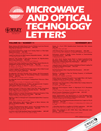Miniaturized size of dual-band-meandered branch-line coupler for WLAN application
Corresponding Author
N. M. Jizat
Wireless Communication Centre (WCC), Faculty of Electrical Engineering, Universiti Teknologi Malaysia, 81310 UTM Skudai, Johor, Malaysia
Wireless Communication Centre (WCC), Faculty of Electrical Engineering, Universiti Teknologi Malaysia, 81310 UTM Skudai, Johor, MalaysiaSearch for more papers by this authorS.K. A. Rahim
Wireless Communication Centre (WCC), Faculty of Electrical Engineering, Universiti Teknologi Malaysia, 81310 UTM Skudai, Johor, Malaysia
Search for more papers by this authorT. A. Rahman
Wireless Communication Centre (WCC), Faculty of Electrical Engineering, Universiti Teknologi Malaysia, 81310 UTM Skudai, Johor, Malaysia
Search for more papers by this authorA. Y. Abdulrahman
Wireless Communication Centre (WCC), Faculty of Electrical Engineering, Universiti Teknologi Malaysia, 81310 UTM Skudai, Johor, Malaysia
Search for more papers by this authorM. I. Sabran
Wireless Communication Centre (WCC), Faculty of Electrical Engineering, Universiti Teknologi Malaysia, 81310 UTM Skudai, Johor, Malaysia
Search for more papers by this authorP. S. Hall
The University Of Birmingham, Edgbaston, Birmingham B15 2TT, United Kingdom
Search for more papers by this authorCorresponding Author
N. M. Jizat
Wireless Communication Centre (WCC), Faculty of Electrical Engineering, Universiti Teknologi Malaysia, 81310 UTM Skudai, Johor, Malaysia
Wireless Communication Centre (WCC), Faculty of Electrical Engineering, Universiti Teknologi Malaysia, 81310 UTM Skudai, Johor, MalaysiaSearch for more papers by this authorS.K. A. Rahim
Wireless Communication Centre (WCC), Faculty of Electrical Engineering, Universiti Teknologi Malaysia, 81310 UTM Skudai, Johor, Malaysia
Search for more papers by this authorT. A. Rahman
Wireless Communication Centre (WCC), Faculty of Electrical Engineering, Universiti Teknologi Malaysia, 81310 UTM Skudai, Johor, Malaysia
Search for more papers by this authorA. Y. Abdulrahman
Wireless Communication Centre (WCC), Faculty of Electrical Engineering, Universiti Teknologi Malaysia, 81310 UTM Skudai, Johor, Malaysia
Search for more papers by this authorM. I. Sabran
Wireless Communication Centre (WCC), Faculty of Electrical Engineering, Universiti Teknologi Malaysia, 81310 UTM Skudai, Johor, Malaysia
Search for more papers by this authorP. S. Hall
The University Of Birmingham, Edgbaston, Birmingham B15 2TT, United Kingdom
Search for more papers by this authorAbstract
A new method of a dual-band miniaturized branch-line coupler (BLC) is presented with two widely separated bands (f2 > 2f1) for wireless local area network application. Partially meandered lines are used as the coupler's shunt arms; and are designed to operate at f1 = 2.45 GHz and f2 = 5.8 GHz. There are 65 and 90% reduction in circuit area compared to the previous research design. Theoutput signal ports have an equal power split within measurement accuracy and 2° error at the resonant frequencies. The simulated and measured results are in good agreement, thereby verifying the design concept. © 2011 Wiley Periodicals, Inc. Microwave Opt Technol Lett 53:2543–2547, 2011; View this article online at wileyonlinelibrary.com. DOI 10.1002/mop.26312
REFERENCES
- 1 N.K. Tsung, S.L. Yo, H.W. Chi, and H.C. Chun, A compact LTCC branch-line coupler using modified-T equivalent-circuit model for transmission line, IEEE Microwave Wireless Compon Lett 16 ( 2006), 90–92.
- 2 V.P. Papantoniou and T.D. Xenos, Development and electro- magnetic characterization of adaptable open-architecture WLAN systems, Prog Electromagn Res PIER 91 ( 2009), 229–242.
- 3 I. Sakagami, K. Sagaguti, M. Fujii, M. Tahara, and Y. Hao, On a lumped element three-branch 3-dB coupler with Butterworth and Chebyshev characteristic, IEEE Int Midwest Circuits Syst Symp 2004, pp. III-21–III-24.
- 4 S.S. Liao and J.T. Peng, Compact planar Microstrip branch-line coupler using the quasi-lumped elements approach with nonsymmetrical and symmetrical T-shaped structure, IEEE Trans Microwave Theory Tech 54 ( 2006), 3508–3514.
- 5 Y.C. Chiang and C.Y. Chen, Design of a wide-band lumped-element 3-dB quadrature coupler, IEEE Trans Microwave Theory Tech 49 ( 2001), 476–479.
- 6 K.W. Eccleston and S.H.M. Ong, Compact planar microstripline branch-line and rat-race couplers, IEEE Trans Microwave Theory Tech 51 ( 2003), 2119–2125.
- 7
M. Hayati and
M. Nosrati,
Loaded coupled transmission line approach of Left-Handed (LH) structures and realization of a highly compact dual-band branch-line coupler,
Prog Electromagn Res C
10 (
2009),
75–86.
10.2528/PIERC09041508 Google Scholar
- 8 S.S. Liao, P.T. Sun, N.C. Chin, and J.T. Peng, A novel compact sized branch-line coupler, IEEE Microwave Wireless Compon Lett 15 ( 2005), 588–590.
- 9 S.S. Liao and J.T. Peng, Compact planar microstrip branch-line coupler using the quasi-lumped elements approach with nonsymmetrical and symmetrical T-shaped structure, IEEE Trans Microwave Theory Tech 54 ( 2006), 3508–3514.
- 10 M.J. Park and B. Lee, Dual-band, cross coupled branch line coupler, IEEE Microwave Wireless Compon Lett 15 ( 2005), 655–657.
- 11 I.H. Lin, M. De Vincentis, C. Caloz, and T. Itoh, Arbitrary dual band components using composite right/left handed transmisión lines, IEEE Trans Microwave Theory Tech 52 ( 2004), 1142–1149.
- 12 H. Zhang and K.J. Chen, A stub tapped branch-line coupler for dual-band operations, IEEE Microwave Wireless Compon Lett 17 ( 2007).
- 13 F.-L. Wong and K.-K.M. Cheng, A novel planar branch-line coupler design for dual-band applications, In IEEE MTT-S Int Microwave Symp Dig Vol. 2, June 2004, Fort Worth, TX, pp. 903–906.
- 14 N.M. Jizat, S.K.A. Rahim, and T.A. Rahman, Dual frequency ISM band butler matrix using planar coupler, IEEE International Conference on Antennas, Propagation and Systems (INAS 2009), 3–5 December 2009.
- 15 N.M. Jizat, S.K.A. Rahim, and T.A. Rahman, Dual band beamforming network integrated with array, 2010 Fourth Asia International Conference on Mathematical/Analytical Modelling and Computer Simulation, 2010, pp. 561–566.
- 16 C. Collado, A. Grau, and F.D. Flaviis, Dual-band planar quadrature hybrid with enhanced bandwidth response, IEEE Trans Microwave Theory Tech 54 ( 2006), 180–188.
- 17 F.L. Wong and K.K.M Cheng, A novel planar branch-line coupler design for dual band applications, IEEE MTT-S International Microwave Symposium Digest ( 2), June 2004, Fort Worth, TX, pp. 903–906.
- 18 R. Sato, A design method for meander line networks using equivalent circuit transformations, IEEE Trans Microwave Theory Tech MTT- 19 ( 1971), 431–442.




